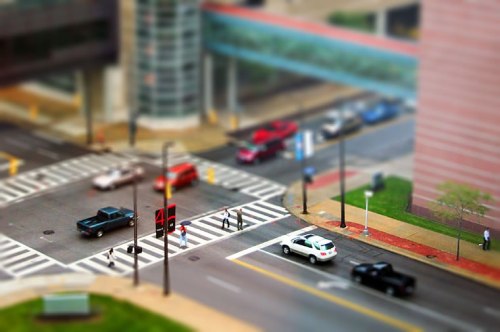I think a good example of this would be taking a photo from a moving car of a distant barn in a field. Depending on the smoothness of the road and the camera, the barn would remain relatively in focus and sharp, as the point of view pertaining to it didn't change much. The fence line in the foreground would be blurry though, and the grass field would start out blurry and become sharper as it retreats towards the barn. If you had focused on, say, the horse in the middle of that field, you would have probably had to angle the camera a bit to keep it centered, thus the fence and the barn would experience motion and focus blur.
The technique I'm most interested in however, is the digital post-production method of blurring an image to simulate a short depth of field. Most of the images are of landscapes, but it can also be utilized more subtly in things like portraits. It's impossible, I'm assuming, to get a short depth of field with the focal point out in the middle of a landscape using any regular size camera. Therefore when this effect is created digitally through blurring, the mind is tricked into thinking this must be a tabletop miniature rather than a lifesize composition. Upon closer scrutiny though, you can see the amount of reality and detail in the landscape. For this reason the method is usually referred to as "tilt-shift miniature faking." I really want to experiment with this and would love to be able to integrate it into my project.



http://en.wikipedia.org/wiki/Tilt-shift_photography
http://en.wikipedia.org/wiki/Tilt-shift_miniature_faking
Philipp Rittermann's dioramas remind me a lot of your work in Studio class too. Your studio images really made me question reality and scale. His are very similar.
ReplyDeletehttp://www.rittermann.com/index.html